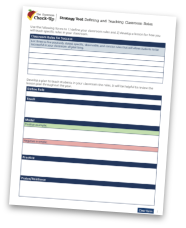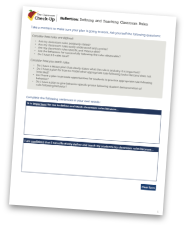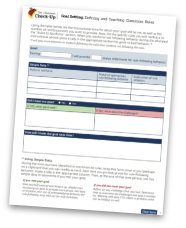Strategy: Defining and Teaching Classroom Rules
Check-Up Menu > Defining and Teaching Classroom Rules
Classroom Rule
How to Define Classroom Rules
| Define Rule |
| Keep your hands and feet to yourself. |
| Teach |
| Provide a verbal description of the rule and its relevance: “We keep our hands and feet to ourselves because it is respectful and keeps us safe.” |
| Model |
| Provide a positive example: “When we sit at circle time, this is what our bodies should look like.”(Demonstrate sitting cross-legged with hands in lap.) Provide a negative example*: Sit down with your legs spread out and nudge a neighbor with your hands. Ask the students “Is this what keeping your hands and feet to yourself looks like?” *It is important that only adults model non-examples. We only want students to practice the positive example of the behavior. |
| Practice |
| Ask for a student to volunteer to demonstrate the rule:
“Lindsay, can you show us what keeping our hands and feet to ourselves looks like?” If possible, allow the entire class to demonstrate the rule: “Now everyone show me what keeping our hands and feet to ourselves looks like.” |
| Praise/Reinforce |
| Provide specific praise to students for appropriate demonstration of the rule:
Devise a plan for reinforcement of rule-following: “During the class instruction, especially during circle time, I will be looking for students who are sitting with their hands and feet to themselves. I will be looking for students who are following the rule.” |


For example, you could say, “Chloe is working hard by completing her morning work.” If no students are following the rule, direct their attention to the rule by saying, “Our first classroom rule is work hard by getting started right away. Talking to your neighbor and not having your materials out is not getting started right away. Everyone show me what getting started right away looks like.”
It is very important that you give more attention to students following the rules than negative attention for not following the rules.

References to Other Relevant Resources:
Sprick, R. (2009). CHAMPS: A proactive and positive approach to classroom management. Eugene, OR: Pacific Northwest Publishing.
Reinke, W., Herman, K., & Sprick, R. (2011). Motivational interviewing for effective classroom management: The classroom check-up. New York, NY: The Guilford Press.


